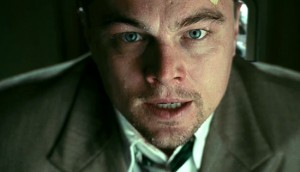 Step 1: Creep you out. Like it or not, director Martin Scorsese uses his Shutter Island to mess with your brain – on all levels – and mostly succeeds in his endeavor.
Step 1: Creep you out. Like it or not, director Martin Scorsese uses his Shutter Island to mess with your brain – on all levels – and mostly succeeds in his endeavor.
Step 2: Create a creepy environ. Based on the novel by Dennis Lehane, Shutter Island zeroes in on Federal Marshal Teddy Daniels (Leonardo DiCaprio), who – when the film opens – is on his way to Boston’s Ashecliffe Hospital, a facility for the criminally insane, located on a remote island off the New England coastline. A patient has gone missing, so Daniels and his new partner Chuck Aule (Mark Ruffalo) are sent in to investigate. Except when they get there, everything immediately seems wonky – from the harsh terrain to the mysterious doctors to the hard-ass guards to the creepy crazies skulking around. Trying to put the pieces together, Daniels soon believes the facility may somehow be involved in a government conspiracy, all while being haunted himself by horrible walking nightmares from his tragic past. He’d better solve this thing fast, so he can get off this god-forsaken rock – or suffer the consequences.
Step 3: Add some creepy characters. Scorsese once again guides his muse DiCaprio in another excellent performance, as the beleaguered Marshal, trying to solve a case while being chased by his own horrifying demons. The character has had some tough times, and DiCaprio expertly carries all the heartache on his shoulders. Daniels is really such a sad man. The rest of the cast also supports him beautifully, including: Ben Kingsley and Max von Sydow, as the hospital’s good doctor/bad doctor duo; Ruffalo as the almost too-understanding partner; Michelle Williams as Daniels’ lost wife; and brief but memorable appearances from Emily Mortimer, Patricia Clarkson, Jackie Earle Hayley and Ted Levine.
Step 4: Stir up all the creepy elements. Of course, Shutter Island‘s real draw is Scorsese’s skillful direction. His choices are mostly masterful but sometimes slightly annoying. For example, the director has a thing for playing up the soundtrack in scenes, to enhance the psychological tension and drama, I suppose – something he also did with Cape Fear – but it’s more distracting than anything else. Shutter Island also drags a little in its pacing, but once Scorsese twists the screws and peels the layers back, you’re completely engrossed and horrified by the proceedings. It also has a lot to do with Lehane’s original narrative. Like his other similar themed books Mystic River and Gone Baby Gone, Shutter Island deals with violence against children in a deep-seated, personal way. One has to wonder what the hell happened to Lehane when he was a kid to make him keep writing about it.
Level of difficulty in watching Shutter Island: only hard because of the subject matter. Shutter Island will still stick with you long after its ended.


One thought on “How to Watch: “Shutter Island””
Comments are closed.